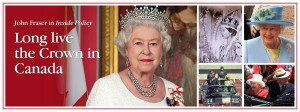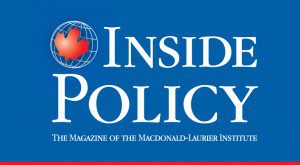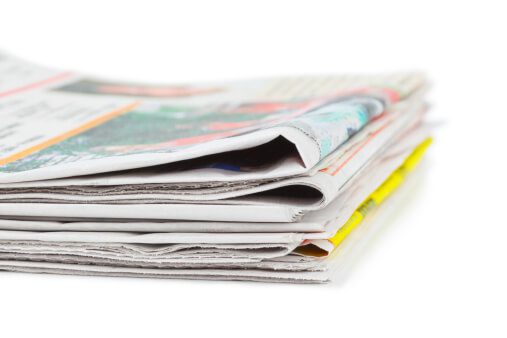 As Canada’s wise and forbearing Queen, Elizabeth II, becomes the longest serving monarch, John Fraser argues in Inside Policy that it is worth considering that a constitutional Crown may be as great an ally to democracy as we have, and to warn against the alternatives proposed by the opponents of this hugely undervalued institution.
As Canada’s wise and forbearing Queen, Elizabeth II, becomes the longest serving monarch, John Fraser argues in Inside Policy that it is worth considering that a constitutional Crown may be as great an ally to democracy as we have, and to warn against the alternatives proposed by the opponents of this hugely undervalued institution.
By John Fraser
The modest but mostly happy celebration to mark Queen Elizabeth’s surpassing of Queen Victoria’s record as the longest reigning monarch in both British and Canadian history, occurring Sept. 9, is a time when the excitable supporters and detractors of the Crown in Canada get a chance to trot out their views.
As the founding president of the Institute for the Study of the Crown in Canada and the author of a book entitled The Secret of the Crown, I clearly am a supporter, but hopefully not a mindless one. The occasion of the simple endurance of this redoubtable, duty-bound sovereign offers an opportunity to explain the benefits the country receives from her mere presence as our head of state, and also to try and sketch how the role of the Crown in Canada has evolved over the long years of her reign.
The Queen has already outlasted the electoral mandates of 10 of her Canadian prime ministers: Louis St. Laurent, John Diefenbaker, Lester Pearson, Pierre Elliot Trudeau, Joe Clark, John Turner, Brian Mulroney, Kim Campbell, Jean Chrétien, and Paul Martin. And she is still counting because at the time of writing, it is not at all clear if her 11th, Stephen Harper, will continue in office or be succeeded by her 12th. And if it is Number 12, there’s a good chance she’ll outlast him too.
Unlike her father, King George VI and all his predecessors acknowledged as heads of state under the Crown of Canada, every one of the Queen’s appointed governors general – who act as a regents and perform the duties of a head of state when Elizabeth is not on Canadian soil — have been quintessentially Canadian, starting with Vincent Massey in 1952 who was named governor general six days before King George died and Elizabeth succeeded to the throne. This particular roll call of her appointed Canadian representative tells a different story than the PM list in two obvious but telling areas — minority and gender leadership. After Mr. Massey’s term, the others have been: Georges Vanier, Roland Michener, Jules Léger, Edward Schreyer, Jeanne Sauvé, Ray Hnatyshyn, Roméo LeBlanc, Adrienne Clarkson, Michaëlle Jeanne and the current incumbent, David Johnston.
The contrast between the elected and appointed “brand” of leadership in our system is even more striking amongst the lieutenant governors of the provinces. Here we find the first Aboriginal representatives of the Crown, the first women, the first blacks, the first Asian-Canadians, and so on. The encompassing model of these appointments, while far from flamboyant, has nevertheless seeped into the Canadian consciousness in very positive ways and helped to shape our collective sense of leadership.
 The Queen has survived this long period despite travelling on a rickety emotional and constitutional roller-coaster which began in a postwar atmosphere of extreme adulation. In the subsequent 63 and a half years, she has borne patiently the slings and arrows of separatist aspirations in Quebec and often inchoate nationalist yearnings in English Canada. She has been afflicted with bozo cabinet ministers assigned to accompany her on royal tours who were avowed republicans, as well as the smug assurances of writers and academics who feel called upon to let her know she and her hard-working heirs are nothing more than a “free-loading” tourists in Canada.
The Queen has survived this long period despite travelling on a rickety emotional and constitutional roller-coaster which began in a postwar atmosphere of extreme adulation. In the subsequent 63 and a half years, she has borne patiently the slings and arrows of separatist aspirations in Quebec and often inchoate nationalist yearnings in English Canada. She has been afflicted with bozo cabinet ministers assigned to accompany her on royal tours who were avowed republicans, as well as the smug assurances of writers and academics who feel called upon to let her know she and her hard-working heirs are nothing more than a “free-loading” tourists in Canada.
Through all of this, through our constitutional ups and downs, through federal-provincial brouhahas on jurisdictional authority, through our seeming inability to deal honourably and intelligently with our great systemic wound of Aboriginal injustice, through our whole story as a sovereign nation these past six decades, she never once – to use her own words – has been “a fair-weather friend” and never once complained. She has done what her Canadian prime ministers and provincial premiers have advised her to do, for good or ill, but she has also kept a tactful distance from their politics. She is experienced and wise beyond measure, and forbearing to a fault.
Well, fairly forbearing! Once, back in the 1980s, when Jean Chrétien was Minister of Justice and brought the latest version of our constitutional patriation act for her formal approval, she received him at Buckingham Palace with an amused and slightly mocking air: “You again!” said the Queen of Canada, a tale Chrétien himself delighted to recount.
Today, although I have no particular manipulated or convoluted opinion polls to support the assertion, it is fairly safe to say that a majority of Canadians accept the status quo of the Crown in Canada. That is, there is no abiding passion — except for a minority who, like myself, tend to the romantic and dramatic side of history. But neither is there abiding repugnance, except for a similar sized minority. It seems to work for us in strange and not easily explicable ways. It also reflects Prime Minister Stephen Harper’s own views, as he himself wrote in a letter to me following the publication The Secret of the Crown:
“I am not the fanatically committed royalist that I am sometimes portrayed,” Mr. Harper wrote after he had read my book on the Crown in Canada. “On the contrary, until fairly recently in my life I was a rather passive and uncommitted supporter of the status quo on the issue of the monarchy. Over the past decade, however, I have had a privileged vantage point from which to observe the many and profound strengths of the institution. I have likewise seen the likely alternatives about which I have become quite alarmed.”
That’s not exactly a rousing endorsement, I admit, but it does seem typically Canadian and I do believe it also reflects a majority viewpoint.
On the other hand, the number of serious citizens who find the business of having an “English/British queen” as our head of state a scandal and bemoan the fact that no Canadian can aspire to the title of “head of state” have serious arguments to posit, arguments which supporters must contend with. As a supporter of the Crown, it often seems necessary to make the case for this hugely undervalued institution, recognizing that there will always be those who will never agree or understand the business. In the end, trying to persuade such folk is not unlike trying to explain an opera to someone fixated on the plot and for whom the music is irrelevant. Nevertheless, here goes:
Any reasonable defense of the Crown in Canada, it seems to me, has to start from three unassailable facts: (1) it exists; (2) it is virtually impossible to eliminate under our Constitution; and (3) in ways most Canadians hardly understand, it actually works quite well.
It exists
I presume I don’t have to prove that that the “Crown of Canada” exists and has existed since the first European incursions in the “new world”. It was against the Crown that the First Nations waged war, made peace and signed treaties. It existed in both the French and British colonial periods. It existed and was crucial throughout the period leading up to and after Confederation. It infuses our parliamentary and social and geographical history.
In the United States, on the other hand, they keep re-electing George III every four years. That’s only partially whimsical sarcasm. When the great slave-owners and others south of the border created the American presidency, they modeled the role of “head of state” on a Hanoverian sovereign. They let their indirectly elected president choose his own cabinet, as George III did. They let him veto bills from the legislative assemblies, as President Obama can still do. Covert wars could be carried on without recourse to Congress as they still can be (until money voted by a lower legislative house is needed to support or expand the wars, which was George’s problem as well). No one imagined that the Crown could or would evolve in the way it has under the parliamentary system where the sovereign continues to uphold the dignity of the state but relinquished its legislative and coercive powers, or where cabinet ministers must go through the discipline of electioneering and endure questioning in the House of Commons.
In Canada, willingly or otherwise, we pledge allegiance to a sovereign and in doing so formally recognize that there is a symbolic power higher than an elected assembly. “If the idea of the Crown – that the people is not sovereign – does not mean that they are not self-governing, what does it mean?” asked the distinguished historian and civil servant Ralph Heintzman a few years ago. “If Canadians enjoy self-government to the same degree as Americans, why should they bother to maintain a very different constitutional fiction at the centre of their theory of the state?”
Beyond the traditional answers, itemized above, Heintzman cites an answer Sir John A. Macdonald once gave: “We have a free Queen over a free people,” Sir John used to say, “governed by the principles of equity, the principles of religion and the principles of morality – which a fierce democracy never has had and never will.”
Heintzman underscored the point of the Crown to show that the symbolism here transcends our notions of governance, but also allows us a chance to deal with some serious notions of how we see ourselves, or should see ourselves, as a nation and a people:
“The symbolic assertion that sovereign authority proceeds from a source above us reminds us that, while we are indeed free to act as we wish, we ought nevertheless to act in certain ways rather than others: while there is noting to stop us from doing any foolish thing we choose, there are nevertheless certain principles, higher than our own petty desires, to which we owe allegiance, and which we neglect or abuse at our peril.”
It is virtually impossible to eliminate
For years now, the opponents of the Crown have tried to offer up easy solutions for eliminating the institution through various re-readings and reinterpretations of our Constitution, but the unassailable fact remains that it needs the approval of all the legislatures of the country and before it could even reach the point of asking the legislatures to ponder, debate and vote on such a course, the nature of the alternative system would have to be resolved. This became virtually entrenched with the constitutional settlements engineered by Prime Minister Pierre Trudeau in 1982.
And even if that could somehow be done, the Australian experience is usefully before us. In 1999, a referendum was held in a country that is our closest constitutional cousin, even closer than Britain actually. It is also a country where opinion polls, those limited and often faulty dried chicken bones of today’s High Oracles of a nation’s mood, clearly showed Australians were ready to ditch their version of the Crown. What happened? When it came time to say aye or nay, it was clear that Australians didn’t fancy any more power going into the hands of an already too-powerful-by-a-half, democratically elected, federal prime minister. It turned out that the Australian Crown would do quite nicely, after all. The “devil-known” trumping the “devil unknown” is, once again, hardly a rousing battle cry, despite the very interesting resonance the word “trumping” now has thanks to the current U.S. Republican primary campaign. But it does reinforce the notion that for the maintenance of civil society and governance, a constitutional Crown may be as great an ally to democracy as we have in our shaky arsenal of constitutional safeguards.
It actually works
Finally, although during the lead- up to the 1867 Confederation, few imagined the role of appointed representatives of the sovereigns, the governors general and lieutenant governors, would evolve into an effective system of embracing and embellishing the happy multicultural reality of Canada, it has become one of the salient and most individualistic features of Canadian governance. The Crown functions efficiently in the quiet areas of legislative approvals, in a system of honours for worthy Canadians, in separating our notion of the state from the sometimes sordid or creepy manifestations of Realpolitik.
It’s true enough that a kid born in Canada today cannot grow up to be in line to sit on the throne of thrones over in Westminster Abbey, although he or she can certainly grow up to sit on the thrones of the Senate chamber where Canadians have invested the authority of the Crown. But a kid born in Canada can actually have a major influence in the affairs of the sovereign. There is a telling incident recounted in a recently published book in Britain, Monarchy and the End of Empire, by Philip Murphy. As Murphy recounts, the Queen was “advised” in 1973 by the British prime minister Edward Heath (who had recently ended an arms embargo against the apartheid state of South Africa) that she should not attend a Commonwealth Prime Ministers Conference in Ottawa. In an adroit countermove, she then asked the advice of Prime Minister Trudeau who said the Queen of Canada should certainly be there. She presided as our head of state and Mr. Heath was shamed into coming.
Indeed, the Queen of Canada has probably been helping the Queen of England on all sorts of subjects on which she is well versed, from separatism in both Quebec and Scotland, to corruption and hanky-panky in legislative upper chambers.
But to my mind, the chief asset and resource this wonderful institution and this remarkable woman can give to Canada at the moment, and well into the future, is to help us continue to heal our greatest systemic wound. If non-Aboriginal Canadians are serious about coming to terms with our past and really want to get to a better future, the symbolism inherent in the Canadian notion of the “Honour of the Crown” – the implicit constitutional obligation to consult with the First Nations on any matters dealing with their historic treaties and all subsequent relations between the government and people of Canada – could offer a safe passage beyond all the hurt and misunderstanding of the past. The Crown and the person of the Sovereign both offer a chance to get back to basics, to get back to a time when in First Nation understanding, the Crown and the First Nations were equals and dealt honourably with each other. Deployed adroitly, the Crown is a neutral and honourable mediating presence in this continuing challenge which should not be dismissed out of hand. Mocking the role of the Crown in Canada also mocks that sacred relationship. Respecting it shows that we are serious about respecting Aboriginal rights. At the root of this argument is an understanding and acceptance of the role of symbolism that has never been a problem for the First Nations, but is misunderstand and undervalued by non-Aboriginal Canadians.
Taking advantage of this gift offered by the great lady still on her throne may yet prove to be the single most important benefit Canadians can receive from the Crown. For that reason alone, the memorable milestone Elizabeth the Second passed this year is worth much celebration.
John Fraser is the master emeritus of Massey College in Toronto and the founding president of the Institute for the Study of the Crown in Canada based at Massey College. On Sept. 1, he became the first president and CEO of the National Newsmedia Council, the successor to several press councils across the country.





